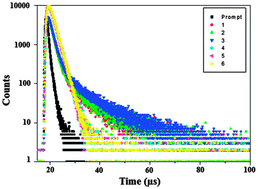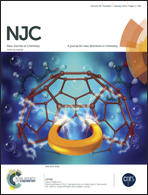Highly phosphorescent green emitting iridium(iii) complexes for application in OLEDs†
Abstract
Phenanthrimidazole based ligands with various substitution patterns have been used as the main ligands for heteroleptic bis-cyclometalated iridium(III) complexes. Two series of complexes have been prepared by changing the ancillary ligand and their electroluminescent properties were studied. The strongly allowed phosphorescence in these complexes is the result of a significant spin–orbit coupling of the iridium center. The absorption at longer wavelengths has been assigned to 1MLCT ← S0 and 3MLCT ← S0 transitions of iridium complexes and the phosphorescence emission maxima range from 558 to 574 nm. The OLEDs with these picolinate complexes exhibit appreciable external quantum efficiencies ranging from 6.5 to 15.6%. Devices based on Ir(tmpmp)2(pic) and Ir(tmpdp)2(pic) show better performance in terms of brightness of 110 421 cd m−2 and 124 568 cd m−2 at 18 V, respectively. Devices with Ir(tmpdp)2(pic) show a high power efficiency of 25.6 lm W−1 at 7.0 V and a current efficiency of 47.5 cd A−1 at 8.0 V. Introduction of the dimethylamino group in 2-picolinate complexes, Ir(tmpmp)2(Npic) (ηc − 44.6 cd A−1, 8 V; ηp − 26.0 lm W−1, 7 V) and Ir(mpdp)2(Npic) (ηc − 49.9 cd A−1, 8 V; ηp − 27.2 lm W−1, 7 V), results in a highly phosphorescent green emitter with high electroluminescence efficiency.


 Please wait while we load your content...
Please wait while we load your content...